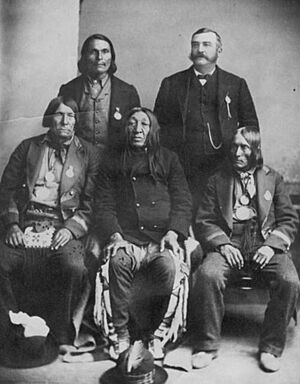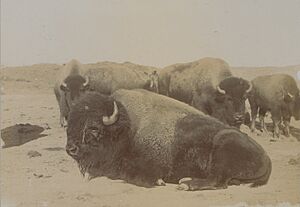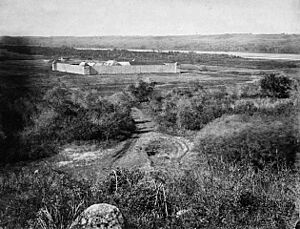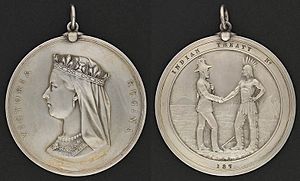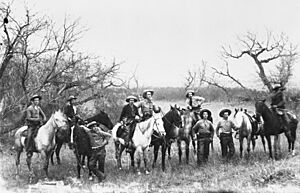Ahtahkakoop facts for kids
Ahtahkakoop (whose Cree name Atāhkakohp means "Starblanket") was a respected leader of the Cree people. He was born around 1816 and lived until 1896. As a chief of the Plains Cree, he guided his people through big changes in the late 1800s. His community shifted from being hunters and warriors to becoming farmers. They also moved from their traditional spiritual beliefs to Christianity.
When Ahtahkakoop became a leader, huge herds of buffalo roamed the northern plains. These buffalo were vital for the Cree way of life, providing food, clothing, and tools. But by the 1860s, the buffalo were quickly disappearing. European settlers were also arriving, changing the balance of the land. Chief Ahtahkakoop understood that his people needed to adapt to survive. In 1876, he and his friend, Chief Mistawasis, signed Treaty 6 at Fort Carlton. By signing, Ahtahkakoop agreed to move his people to a reserve at Sandy Lake. This reserve was about 67 square miles, located northwest of what is now Prince Albert, Saskatchewan.
Contents
Early Life and Traditions
Ahtahkakoop was born around 1816 near the Saskatchewan River. His father, Antoine Chatelain, was French or French-Métis, and his mother, Okimawinotook, was Métis. He had four brothers: Masuskapoe, Sasakamoose, Ahenakew, and Nāpēskis. Many people today are descendants of Ahtahkakoop and his brothers.
Ahtahkakoop grew up learning the traditional ways of the Plains Cree. His family lived as hunter-gatherers. Each summer, they would travel to the prairie grasslands with other band members. There, they hunted buffalo and gathered roots, herbs, and berries. Buffalo were incredibly important. They provided not just food, but also hides for tipis, clothing, bags, and cooking tools. In winter, families would move to the parklands. They hunted elk, moose, and deer, in addition to buffalo. As spring approached, they hunted birds like geese and ducks. They also gathered sap from maple and birch trees to make syrup and sugar.
Spirituality was a key part of Plains Cree life. From a young age, Ahtahkakoop learned stories about the Creator and spirit helpers. He also learned about ceremonies, prayers, and songs. When he was old enough, he took part in these ceremonies. These included smudging (a purification ritual), pipe ceremonies, and sweat lodges. A very important ritual for young men was the vision quest. Around age 14, Ahtahkakoop would have gone alone into the hills or forests. He would fast without food or water, hoping to receive a vision from the Creator. This ritual was a significant part of growing up and becoming an adult.
Ahtahkakoop Becomes Chief
Ahtahkakoop was known for his strong leadership skills throughout his life. Even as a young man, people noticed his ability to take charge and guide his community. He was skilled at finding the best places for camps and hunting buffalo. He was also an impressive hunter himself.
His skills as a warrior were especially famous. Many stories tell of his brave battles against other tribes. In one story, he led his group to victory against Blackfoot warriors, even when outnumbered. This showed his potential as a great leader. It also showed that the spirits favored him and that his spirit helpers were powerful.
Ahtahkakoop became a chief sometime in the 1850s, or possibly even earlier. His band was part of the "Fort People" (wāskaahikaniyiniwak). They were called this because they lived close to Fort Carlton. Their territory stretched north, west, and southwest of Fort Carlton. Ahtahkakoop usually hunted north of the Bad Hill, which is northwest of modern-day Rosetown.
The other main chief of the Fort People was Mistawasis. Ahtahkakoop and Mistawasis were close friends and allies for their entire lives. They often camped near each other and hunted together in the summers. Their families were also connected through marriage. Ahtahkakoop's oldest son, Kā-miyo-ahcahkwēw (Good Spirit), married Mistawasis' daughter Judique. Ahtahkakoop's daughter Isabella married Mistawasis' oldest son, Wēyatōkwapew (Lively Man). Both chiefs also worked closely with the Hudson's Bay Company, which recognized them as important leaders.
As a respected chief, Ahtahkakoop had multiple wives. He is known to have had at least three wives. One was named Mary, and she was the daughter of another chief named Nātowēw. These women played important roles in managing the band's work and family matters. They likely came from other important bands, as marriages between bands helped create strong ties and alliances.
Working with John Hines
In the summer of 1874, Ahtahkakoop and his band visited Fort Carlton for supplies. There, he briefly met a young missionary named John Hines. Ahtahkakoop had been looking for someone to help his people adapt to the changing world. They parted ways, but when Ahtahkakoop heard Hines was living nearby, he visited him. Ahtahkakoop suggested that Hines move his settlement to Sandy Lake (yēkawiskāwikamāw) and become a minister there. In October of that year, Hines moved to Sandy Lake, settling on Ahtahkakoop's land. This land was much better for farming than Hines's previous locations.
Ahtahkakoop had met missionaries before. Roman Catholic priests had visited his people and baptized his children. However, Ahtahkakoop himself had not yet converted. He was baptized on May 20, 1877, along with his wife. She had been careful about converting to the Church of England because it was different from the church her children had joined. Ahtahkakoop not only introduced Hines's teachings to his own people but also to other bands, like Mistawasis's. He believed that people converted to Christianity because they chose to, not because of his or Hines's efforts.
Ahtahkakoop had hoped earlier missionaries would send someone to educate his children, but they had not. So, he was excited for Hines to start teaching at his camp. Hines set up a day school at Sandy Lake. Later, he opened more schools at other camps. One of these was at Stony Lake, run by a former student from the Sandy Lake school.
Ahtahkakoop was interested in both religious and practical teachings from Hines. He also wanted to learn about agriculture. Ahtahkakoop knew the buffalo were declining, and his people needed a new way to live. He decided that farming would provide the most stable income for his band. Hines taught Ahtahkakoop and his people how to sow grain and plant gardens. At times, Ahtahkakoop's land had between 20 and 120 acres used for farming. Later, the Government of Canada praised Ahtahkakoop and Hines for their farming efforts.
Signing Treaty 6
On August 15, 1876, Ahtahkakoop and other chiefs met with government officials at Fort Carlton. Negotiations began on August 18. By August 23, Treaty 6 was signed. Mistawasis signed first, followed by Ahtahkakoop and 11 other chiefs. Lieutenant-Governor Alexander Morris oversaw the signing. Each chief received a medal and a flag. As head chiefs, Ahtahkakoop and Mistawasis also received special government uniforms. These included a scarlet coat with gold trim, a felt top hat, pants, a shirt, and a handkerchief. They were told that by accepting these, they became representatives of the Queen.
Ahtahkakoop understood that the world was changing. The buffalo were disappearing, and more settlers were arriving. He saw the need for his people to learn new ways of life. He was concerned for his people and future generations. He believed signing the treaty and following its terms were crucial for their success. Some other chiefs, like Poundmaker, Badger, and Young Chipewyan, were against signing the treaty and dividing the land. However, after hearing speeches from Ahtahkakoop and Mistawasis, they were convinced that the treaty was important for their people's future.
As a chief, Ahtahkakoop signed on behalf of his people who wanted to share the land peacefully with settlers and the government. He and the other chiefs negotiated hard to get as much help as possible for their people. Even though Ahtahkakoop's people had already started farming, he wanted a safety net in case of hard times. So, a key part of the treaty was the "famine clause" and the "medicine chest." These resources would be kept by an Indian Agent on each reserve. They were for times of famine or medical emergencies, like outbreaks of diseases such as smallpox or tuberculosis. The chiefs also asked for more support for farming, like supplies and oxen, to help with the transition.
Despite Ahtahkakoop's good intentions, there were misunderstandings about how the treaty terms would be followed. This was due to differences in traditions between the Cree and the European settlers. Ahtahkakoop and the other chiefs believed that everything said and promised orally during negotiations was legitimate. This was because a sacred pipe was present during the talks. However, government officials believed only what was written in the treaty was legitimate. Because interpreters were used, there was miscommunication on both sides about what was included. It's likely that much of Treaty 6 was already written when Morris arrived. Still, Ahtahkakoop and the other chiefs successfully persuaded Morris to add more terms to the treaty. Ahtahkakoop was satisfied, knowing it wasn't possible to agree on every single issue.
North-West Rebellion
On March 20, 1885, a messenger from Fort Carlton arrived at Ahtahkakoop's door. He was told that the Métis people had taken weapons and ammunition and captured men. Ahtahkakoop quickly prepared, picked up Mistawasis, and headed to the fort. At Fort Carlton, they met many men, including some from Prince Albert, who had come to defend the fort. They learned that Louis Riel had formed his own government and started a rebellion. Riel and Gabriel Dumont were demanding that the fort be handed over. Riel claimed his actions were right because he felt the government had failed to help the Métis.
Ahtahkakoop and Mistawasis were asked where their loyalty stood. Both men were determined to honor the treaty they had signed less than 10 years earlier. They stated they would remain neutral during the conflict. By this time, both men were nearly 70 years old. Despite their past as brave warriors, they doubted they would be much help on the battlefield. So, they told officials that if Riel's forces could not be stopped, they would take their people to Prince Albert for safety. Happy with their promise of loyalty, officials agreed to provide protection and supplies if an evacuation was needed. Even though Riel asked them many times to join his forces, Ahtahkakoop and Mistawasis stayed true to their word and remained neutral throughout this difficult time.
Legacy
Ahtahkakoop passed away on December 4, 1896, at about 80 years old. It is believed he had a heart attack while walking with his grandson, Pacī (James Starblanket). His son, Ka-miyoastotin (Basil Starblanket), became the next Chief. Ahtahkakoop was buried on the reserve named after him. In 1993, a high school named Ahtahkakoop was built on the Ahtahkakoop Reserve. This school honors him and other band members. Its Hall of Achievement displays the accomplishments of the Cree people.
See also
- Ahtahkakoop First Nation


